Clownfish are popular for several reasons!
They are the epitome of reef beauty, with bold, brilliant colors. And the way these reef-safe species swim about in their wobbly way is charming and fun to watch.
But did you know that there are literally dozens of types of clownfish to choose from?
In this clownfish species guide, we’ll be taking the time to introduce you to as many as we can in such a short time together!
Getting to Know Clownfish

Clownfish are a classic example of a natural mutualistic relationship. This is where two or more species enter into a partnership where all members benefit from the association. In this case, the clownfish gains protection from predators and a place to live and raise its young.
And the sea anemone gains a protector; clownfish are famously territorial and will drive off butterflyfish and other anemone-eaters.
From long association with their host anemones, clownfish also have a distinctive, rather goofy way of swimming! They use their pectoral fins to sort of pull themselves through the water in a wobbly yet adorable manner!
Favored Host Anemone Species
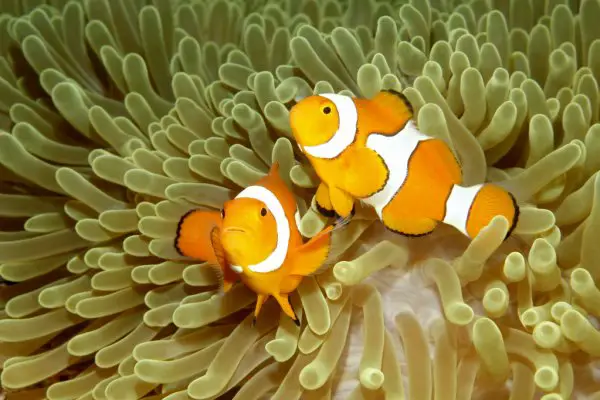
Most types of clownfish have a strong preference for one or more species of sea anemone. They form these preferences due to millennia of association in the wild. It is not set in stone, and many can be quite flexible. But if you want to watch the symbiotic bond between a clownfish and its anemone, then choosing the right species from this list will help you succeed!
- Adhesive Sea Anemone (Cryptodendrum adhaesivum)
- Bubble Tip Anemone (Entacmaea quadricolor)
- Magnificent Sea Anemone (Heteractis magnifica)
- Delicate Sea Anemone (Heteractis malu)
- Beaded Sea Anemone (Heteractis aurora)
- Sebae or Leathery Anemone (Heteractis crispa)
- Saddle Carpet Anemone (Stichodactyla haddoni)
- Merten’s Carpet Anemone (Stichodactyla mertensii)
- Long Tentacle Anemone (Macrodactyla doreensis)
- Giant Carpet Anemone (Stichodactyla gigantea)
Do Clownfish Need Sea Anemones?
Not necessarily, no. Watching clownfish engage with a sea anemone is one of the most fascinating aspects of their care. But it’s also true that anemones are fairly difficult animals to care for if you are a beginning marine aquarist.
Like corals and other reef tank organisms, sea anemones need bright lighting of the proper spectrum to feed their photosynthetic symbiotic algae. They are also highly sensitive to nitrates and other nitrogenous waste products. And a few, such as the larger carpet anemones, are infamous for eating fish and other tank mates.
So only keep an anemone if you are willing to deal with the difficulties of their care. Most common clownfish do perfectly well living alongside other saltwater fish instead. And captive-bred clownfish are even more at ease without a host anemone!
Popular Clownfish Species and Complexes
Percula Clownfish Complex
When most people think of clownfish species, they are likely thinking of members of the Percula complex. These are the most easily recognizable species since they are just like the world-famous Nemo of Disney-Pixar fame! This group has two members: the True Percula Clownfish and the False Percula Clownfish or Ocellaris Clownfish.
1. Percula Clownfish

True Percula Clownfish can be told from the “false” kind by examining their eyes and white bands. Perculas have a thicker black band around the central white stripe compared to the Ocellaris Clownfish. And the color of their irises is light orange, not nearly as dark as an Ocellaris Clown.
At a petite 3 inches fully grown, the Percula Clownfish is one of the smallest species. It’s better to keep this species with its favored anemones since they can be timid to the point of being shy and appreciates being able to retreat from other fish. Perculas are also one of the more sensitive species to poor water quality, making them better suited to intermediate and advanced aquarists. Should they become too debilitated by nitrogenous wastes, they can easily develop Marine Ich (Cryptocaryon irritans) or Clownfish Disease (Brooklynellosis).
- Scientific Name: Amphiprion percula
- Region: New Guinea & Northern Australia
- Length: 3 inches
- Aquarium Size: 20 Gallons
- Ease of Care: Intermediate
- Temperament: Peaceful; Shy
- Favored Anemones: Giant Carpet, Merten’s Carpet, Sebae, Magnificent, Bubble Tip
2. Ocellaris Clownfish

This species is also known as the Common Clownfish because of all the types of clownfish out there; this is the one you’re most likely to see in pet stores. It also goes by “False” Percula Clownfish since it’s nearly identical to the smaller, more desirable “True” Percula Clown.
In truth, the Ocellaris Clownfish is one of the most desirable species in the hobby. It’s hardy, inexpensive, beautiful, and peaceful. They are also commonly found captive bred, which takes the pressure off of wild clownfish stocks and preserves reef health!
- Scientific Name: Amphiprion ocellaris
- Region: Eastern Indian & Western Pacific Ocean
- Length: 3-4 inches
- Aquarium Size: 20 gallons
- Ease of Care: Very Easy
- Temperament: Peaceful
- Favored Anemones: Magnificent, Giant Carpet, Merten’s Carpet, Bubble-Tip
Maroon Clownfish Complex
The Maroon Complex has a single member; Premnas biaculeatus, the Maroon Clownfish. This species gets its name from the deep, ruddy red color of its flanks. Despite its beauty, beware of its especially aggressive nature!
3. Maroon Clownfish

Maroon Clownfish are something special and a favorite of aquarists of all skill levels. They are the largest clownfish species, with females easily topping 7-8 inches. However, they are also likely the most aggressive species of clownfish.
Maroon Clownfish are highly personable and often learn to recognize their owners. They may even put on threat displays if intruding humans get too close to the tank, especially the larger and more territorial females.
But they can also be downright hateful towards a fish they decide should not share their tank, harassing it mercilessly until it dies. There is also a Gold Striped Maroon Clownfish; this fish is actually a color variant of the standard Maroon Clownfish rather than a separate species.
- Scientific Name: Premnas biaculeatus
- Region: Western Pacific Ocean
- Length: 7-8 inches
- Aquarium Size: 55+ Gallons
- Ease of Care: Easy
- Temperament: Aggressive
- Favored Anemones: Bubble-Tipped
Tomato Clownfish Complex
The tomato complex is one of the smaller groupings, with only two species commonly found in the trade. Tomato complex clownfish are easily recognized thanks to their single wide stripe along their gill covers and chunkier physical profile.
4. Tomato Clownfish

The most widely available is the aptly named Tomato Clownfish. Its mixture of brilliant red and a chocolate brown to black patch is striking. This complex is known for being more aggressive than many other clownfish. So watch the Tomato clownfish as it engages with its tank mates for territorial nipping and chasing.
Tomatoes are much pickier than other clownfish when it comes to choosing a sea anemone to bond with. They exclusively partner with Bubble-Tipped Anemones in the wild. Sometimes they may also join with a Sebae Anemone but less frequently.
- Scientific Name: Amphiprion frenatus
- Region: Western Pacific Ocean
- Length: 5 inches
- Aquarium Size: 30 gallons
- Ease of Care: Very Easy
- Temperament: Semi-Aggressive
- Favored Anemones: Bubble Tipped
5. Cinnamon Clownfish
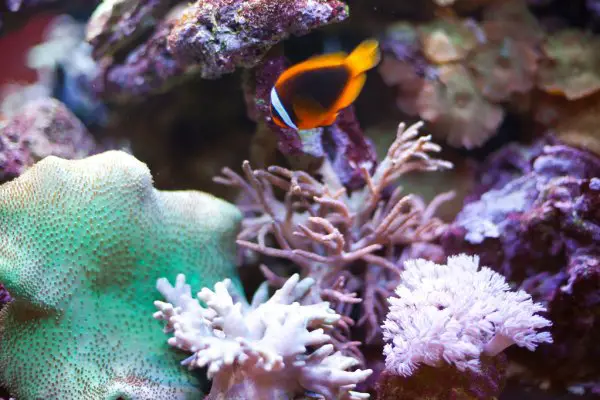
The Cinnamon Clownfish is another semi-aggressive member of the Tomato complex. It’s also one of the larger species of clownfish, regularly reaching 5 to 6 inches. Cinnamon Clownfish need more space as a result. That said, keeping them with a host anemone can make things easier for tank mates since they will limit their territory to the anemone’s boundaries!
- Scientific Name: Amphiprion melanopus
- Region: Pacific Ocean
- Length: 5-6 inches
- Aquarium Size: 40+ Gallons
- Ease of Care: Very Easy
- Temperament: Semi-aggressive
- Favored Anemones: Bubble Tipped; Sebae
Skunk Clownfish Complex
The Skunk Complex has two species that are regular additions to the aquarium trade: the Orange and Pink Skunk Clownfish. The single white stripe leading down their backs makes it obvious how they get their name. As a rule, Skunk Complex clownfish are smaller, more peaceful residents and highly desirable for reef tanks when paired with their favored anemone!
6. Pink Skunk Clownfish
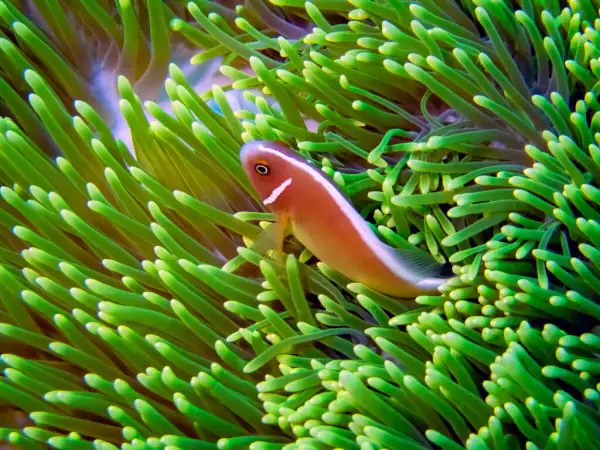
Pink Skunk Clownfish are a special case and need to be treated as such. Most other clownfish species can be kept with or without a host sea anemone. But Pink Skunk Clownfish tend to be severely stressed without one. They are small fish that happen to be very poor swimmers, so keep them with an anemone whenever possible.
Unfortunately, they are not hardy fish; Pink Skunk Clownfish are also more susceptible to poor water conditions than other species of marine fish. Like the Perculas, they will develop diseases if water quality is not carefully monitored. But water conditions ideal for anemone health will also serve to keep your Pink Skunks happy!
Lastly, Pink Skunk Clownfish are famous for being very social and tolerant, not only of each other but even other species of clownfish! It’s not uncommon in the wild for them to live side by side in small colonies. Or even share a large anemone with Clarkii and Percula Clownfish!
- Scientific Name: Amphiprion perideraion
- Region: New Guinea and Northern Australia
- Length: 2-3 inches
- Aquarium Size: 20 Gallons
- Ease of Care: Difficult
- Temperament: Peace
- Favored Anemones: Long Tentacle, Giant Carpet, Magnificent, Sebae
7. Orange Skunk Clownfish
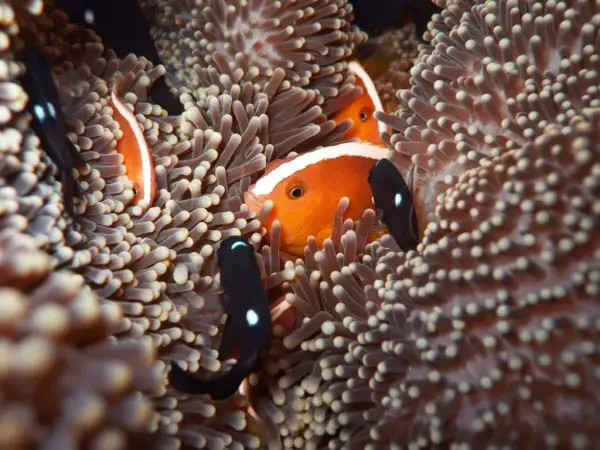
The last major member of this complex is the Orange Skunk Clownfish. Aptly named, its brilliant orange flanks make it easy to tell it apart from its smaller, more delicate cousin. Orange Skunk Clownfish are better for beginners as they can live alongside other fish without an anemone nearby.
While they are slightly larger, they remain peaceful community and reef aquarium inhabitants as well. And they can be convinced to share larger anemones with each other as well as Clarkii and Percula Clownfish when the conditions are right!
- Scientific Name: Amphiprion sandaracinos
- Region: Western Pacific Ocean
- Length: 4 inches
- Aquarium Size: 30 gallons
- Ease of Care: Moderate
- Temperament: Peaceful
- Favored Anemones: Sebae, Merten’s Carpet, Bubble Tip
Saddleback Clownfish Complex
There are several species in this complex, including the Sebae Clownfish and Oman Clownfish. But the complex’s namesake, the Saddleback Clownfish, is the one most commonly found in the trade.
8. Saddleback Clownfish

Saddleback Clownfish are a medium-sized species with a very unique pattern. Rather than just vertical stripes, they have a distinctive white saddle on the dorsal fin extending down their backs without meeting the belly.
They also differ from their cousins in size; males and females are the same size, unique for clownfish. They also form social groupings where a dominant pair lords over the anemone with several subdominant individuals and pairs in the wild. Saddlebacks may even share anemones with Clarkii, Perculas, or Skunk Clownfish. They prefer the Saddle Carpet Anemone above all others and are difficult to host with other species.
- Scientific Name: Amphiprion polymnus
- Region: Western Pacific
- Length: 4 inches
- Aquarium Size: 30 gallons
- Ease of Care: Very Easy
- Temperament: Peaceful
- Favored Anemones: Saddle Carpet
Clarkii Clownfish Complex
The Clarkii Complex is the last of the six clownfish complexes but also one of the largest. 11 species are found in the Clarkii Complex, several of which are nearly as large as the Maroon Clownfish. Clarkii tend to be not as brilliantly colored as their smaller relatives but are very hardy and inexpensive! Several are also extremely rare and limited to a small region of the ocean.
9. Clark Clownfish
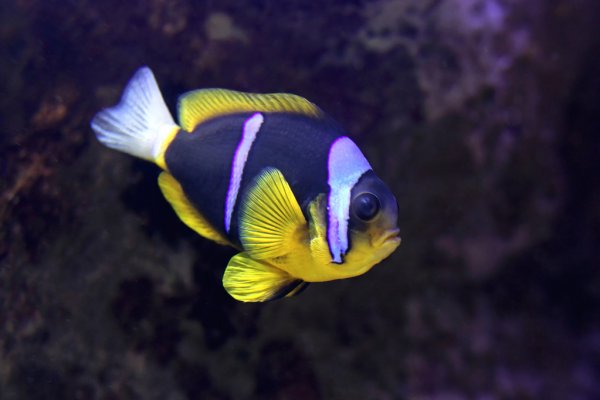
The most commonly found member of this complex is the one it’s named for: Clarkii or Clark’s Clownfish! This species regularly reaches 6 inches in length and is found throughout the Indian and Western Pacific Oceans.
Despite their size, they aren’t nearly as aggressive as Tomato or Maroon Clownfish. In fact, Clarkii Clownfish will readily share anemones with others of their own kind or other complexes.
Clarkii Clownfish are also supremely flexible in choosing sea anemones and will bond with any of the ten species that clownfish favor! They are also the most self-reliant and strong swimmers; should there not be an available anemone around, it doesn’t stress them as it would a Percula or Pink Skunk Clown.
- Scientific Name: Amphiprion clarkii
- Region: Indian and Western Pacific Ocean
- Length: 6 inches
- Aquarium Size: 40 gallons
- Ease of Care: Easy
- Temperament: Peaceful to Semi-Aggressive
- Favored Anemones: All 10 species
Conclusion
Clownfish come in far more colors, sizes, and temperaments than most aquarists realize! While most folks immediately think of the brilliant orange and smaller Perculas, there are giant Maroons, petite Pink Skunks, and many other species worth getting to know.
So choose carefully before setting up your first anemone and clownfish aquarium as clownfish costs vary!
Related:

